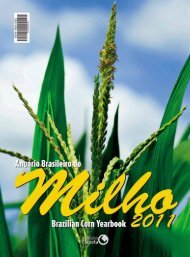tradicionalmenteinovador - Brazil Buyers & Sellers
tradicionalmenteinovador - Brazil Buyers & Sellers
tradicionalmenteinovador - Brazil Buyers & Sellers
You also want an ePaper? Increase the reach of your titles
YUMPU automatically turns print PDFs into web optimized ePapers that Google loves.
Potatoes emerge as front runners<br />
in <strong>Brazil</strong>ian horticulture and with three<br />
crops a year, they occupy by far the biggest<br />
planted area, which in 2009, latest<br />
data available, reached 139 thousand<br />
hectares, down slightly from the previous<br />
year, according to data released<br />
by the <strong>Brazil</strong>ian Institute of Geography<br />
and Statistics (IBGE) and Embrapa Vegetables,<br />
in Brasília (DF). For 2010 and<br />
2011, the Systematic Agricultural Production<br />
Survey, conducted by the IBGE<br />
and disclosed in May 2011, pointed to<br />
a recovery in planted area, projected<br />
to reach 142 thousand hectares and<br />
151 thousand, respectively, thanks to<br />
the better prices in the previous crops,<br />
which had receded in size due to climatic<br />
problems.<br />
The value of the production also<br />
stands out in this crop, with the prospect<br />
for a total of R$ 4.3 billion in 2009.<br />
But what is really noteworthy in this<br />
crop is its socioeconomic importance,<br />
particularly in terms of job generation,<br />
where the sector is a leader, offering 1.2<br />
million opportunities.<br />
The production of potatoes, according<br />
to the official numbers in 2009, remained<br />
at 3.44 million tons, but with<br />
projected increases for the following<br />
years, with estimates pointing to the<br />
possibility to outstrip the record 2008<br />
crop, when 3.8 million tons were harvested.<br />
The Southeast, particularly<br />
the State of Minas Gerais, boasts the<br />
biggest share in the total production<br />
volumes, mostly concentrated in the<br />
southern portion of the State, Triângulo<br />
Mineiro and Alto Paranaíba, besides areas<br />
like Várzea Grande (SP). The crop is<br />
also widely spread across the southern<br />
states of <strong>Brazil</strong>.<br />
The total planted area was bigger<br />
in the 1970s, when it reached upwards<br />
of 200 thousand hectares, but then priority<br />
was given to productivity, which<br />
soared significantly over the subsequent<br />
years. In three decades, yields<br />
improved 132% or more. According to<br />
researchers Waldemar Pires de Camargo<br />
Filho and Felipe Pires de Camargo,<br />
of the Agricultural Economy Institute<br />
and Agribusiness Technology Agency<br />
of São Paulo (IEA-Apta), production<br />
technology was improved and new areas<br />
were devoted to the crop in Goiás<br />
(second crop) and in Bahia (third crop),<br />
where production costs are lower, climate<br />
conditions are stable and irrigation<br />
is available.<br />
>> FROM ABROAD Although<br />
celebrating high production volumes,<br />
potatoes are always a major item in the<br />
annual imports of horticultural products,<br />
which also include the purchase of<br />
potato seed from abroad. In 2010, the<br />
crop ranked first in horticulture imports,<br />
with 276 thousand tons, much below<br />
last year’s 173 thousand tons. Major imports<br />
include frozen pre-fried potatoes,<br />
semi-fresh or frozen. For this reason, the<br />
recommendation is for expanding the<br />
industrial processing operations of potatoes<br />
produced in <strong>Brazil</strong>.<br />
This is one of the ways to boost the<br />
consumption of the <strong>Brazil</strong>ian crop,<br />
which is also a front runner in this specific<br />
matter. Nonetheless, there has<br />
also been a reduction in the amount<br />
consumed, which, according to IBGE<br />
surveys, conducted from 2002 to 2008,<br />
dropped from 5.27 to 4.04 kilos per<br />
person/year, in the case of the Irish potato,<br />
or with the inclusion of the nonspecified<br />
data, from 6.56 to 5.60 kilos.<br />
This fact suggests alternatives to allure<br />
consumers who want the traditional<br />
potato in their diets.<br />
Inor Ag. Assmann<br />
45





